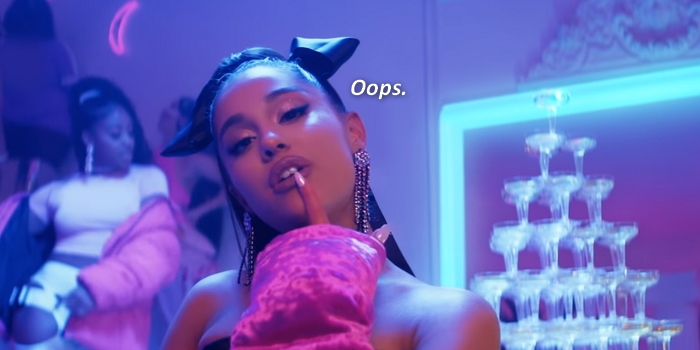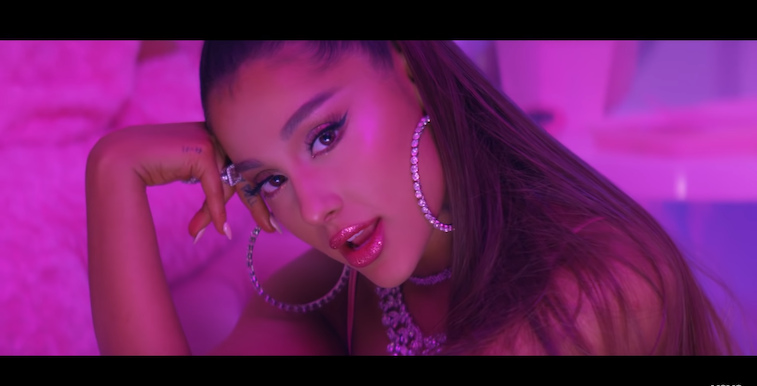

While it’s possible that one or all of these songs could have been a model for “7 Rings,” taken together, the claims start to undermine each other, suggesting a broader stylistic trend is at play. “Mine” not only shares the same downbeat-gracing flow as the other songs, it repeatedly uses the same short-long rhythm heard in Soulja Boy’s and Grande’s song on the chorus phrase, “I bought it,” which certainly echoes in “I got it.” (Of course, Nokia’s chorus, “It’s mine … I bought it” itself echoes 2 Chainz’s, “It’s mine … I spend it.”) Princess Nokia can claim the closest semblance in both rhythm and lyrics. Like the B section of “7 Rings,” the chorus of “Pretty Boy Swag” lands its lyrics directly on the downbeats, often with a second syllable quickly following - compare, “ pretty” to “ want it” or “ got it.” While Soulja Boy only occasionally employs this rhythmic device, Grande does it on almost every other beat - a small distinction, but one that, technically, differentiates the two songs.Īs for 2 Chainz’s “Spend It,” the song features the same downbeat-based cadence, and his lyrics present additional parallels - he says “I’ll spend it” where Grande sings “I got it” and “just bought it.” But, crucially, he uses a slightly different rhythm than Soulja Boy and Grande, evenly dividing the beat rather than following a short note with a long one.

But should they? A closer examination complicates a rush to judgment. Rodgers and Hammerstein have writing credits for “7 Rings.” (In fact, the company that owns their catalogue controls 90 percent of the songwriting royalties.) Princess Nokia, Soulja Boy, and 2 Chainz do not. In it, Grande trades in her croon for a whispered swagger, bouncing quick, sputtered syllables off the beat, “I want it, I got it.” But the hook that placed the song in hot water turns out to be the simpler one, from its B-section. The first cleverly transforms the well-worn waltz of Rodgers and Hammerstein’s 1959 song “My Favorite Things” from The Sound of Music into an Atlanta-style hemiola, also known as the “Migos Flow.” Substituting “bottles of bubbles” for “whiskers on kittens,” Grande turns the Broadway duo’s triple-time rhymes into trappy triplets. Like most songs aimed at the charts, “7 Rings” is built around at least two hooks. And 2 Chainz’s fans noted similarities between “7 Rings” and the rapper’s “ Spend It ” (2011). Soulja Boy called Grande an outright thief on Twitter for copying his song, “ Pretty Boy Swag ” (2010). Princess Nokia was the first to call Grande out, tweeting that it “sounds about white” that the artist copied her flow from “ Mine ” (2017). So when Ariana Grande’s “ 7 Rings ” began climbing the charts with a rhythmic cadence that reminded a lot of people of a lot of other songs, it quickly became a platform for discussions of what we deem original and what we hold as communal.

At a time when the language of pop is as referential, intertextual, and, sure, derivative as ever, teasing out the lines of influence has become a prominent part of public conversations among artists and fans. Social media fuels the rush to litigate whether familiar riffs and rhythms are exclusive or communal property - debates that are fueled by a history of racial injustice in the music industry. Illustration: Mike McQuade and Photos by Kevin Winter/Getty Images, Joseph Okpako/WireImage and Ethan Miller/Getty Images.Īllegations of copying and cultural appropriation are hardly new to popular music, but today, it can feel like nearly every big hit becomes a target.


 0 kommentar(er)
0 kommentar(er)
